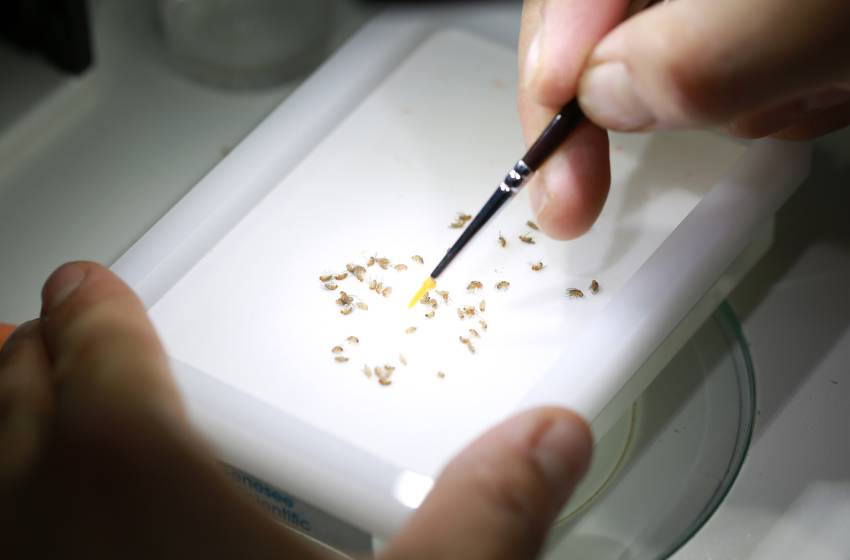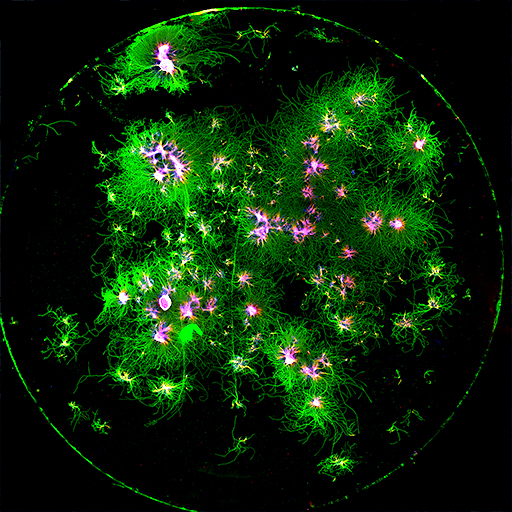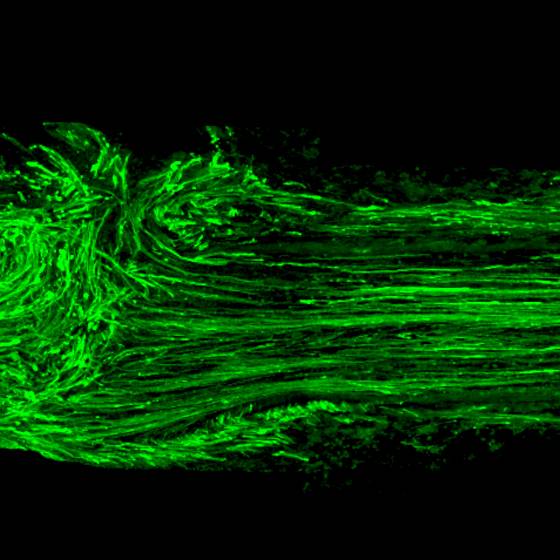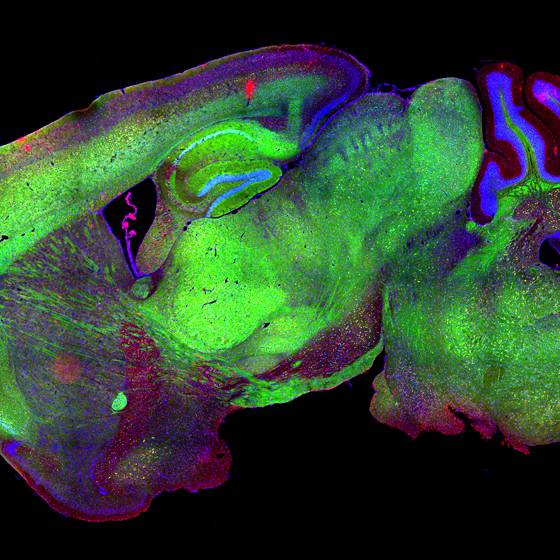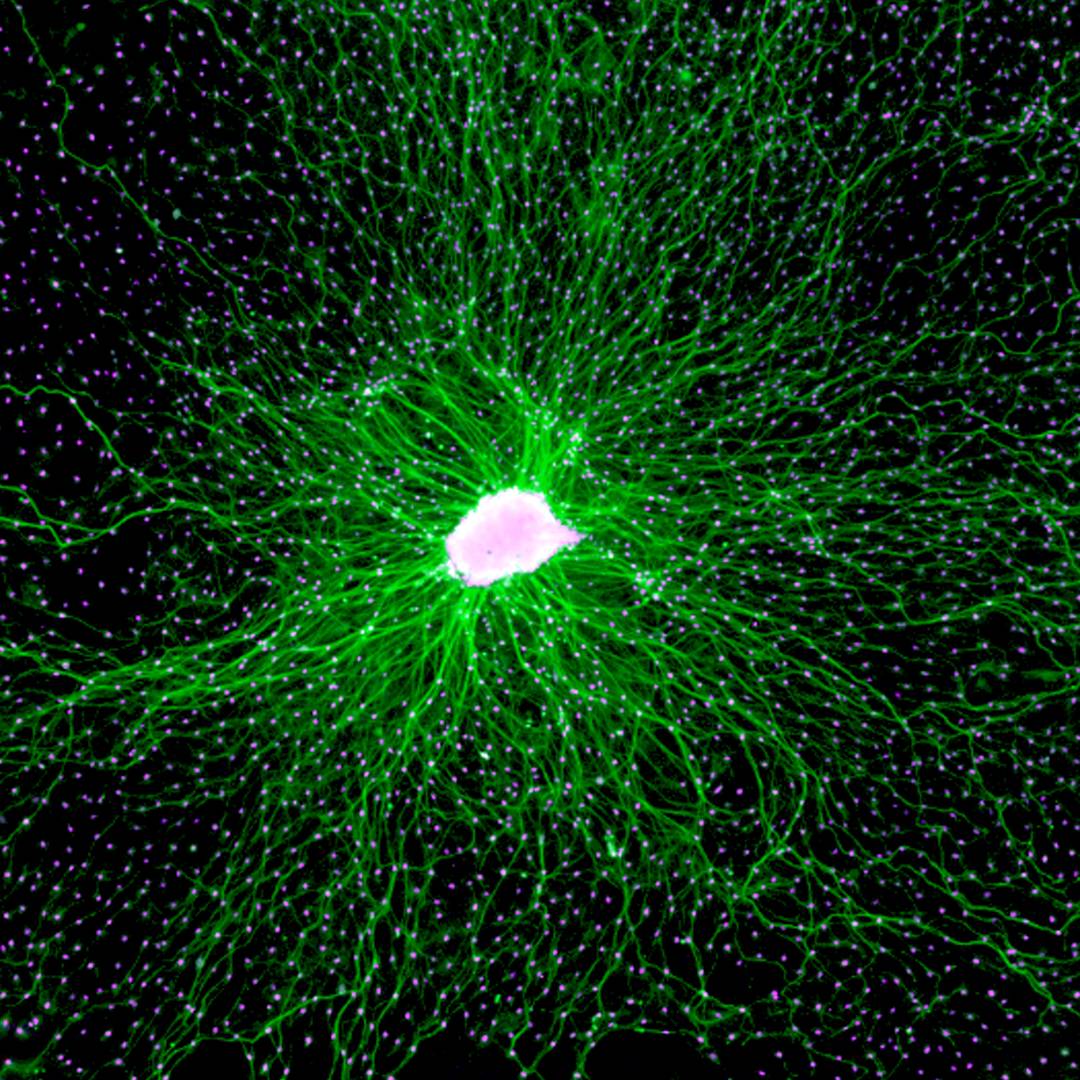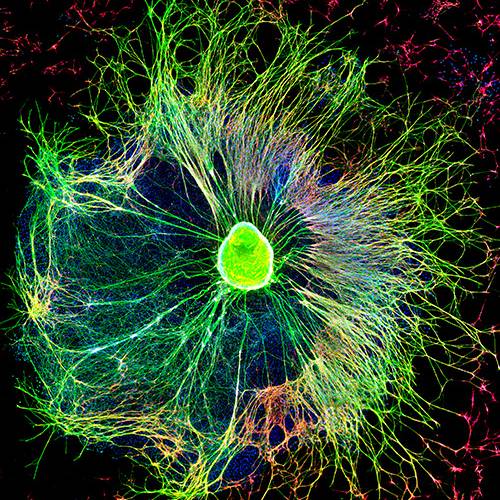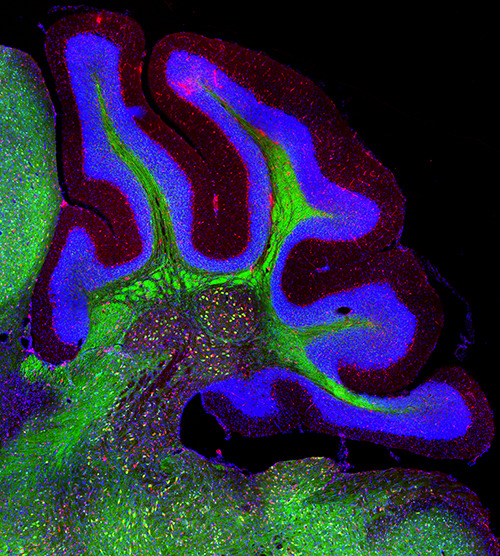Schwann cell regulation of axonal regeneration
In the mammalian nervous system, the regenerative capabilities of neurons show regional variability. In the peripheral nervous system (PNS), axons efficiently regenerate after nerve damage associated to the pro-regenerative effect of Schwann cells. In contrast, in the central nervous system the regenerative capability is poor due to both neuronal intrinsic limitations and glial responses that restrict regeneration. Although, axonal regeneration in the periphery show good regenerative capacity in preclinical models, it still represents a clinical problem associated to delayed repair of peripheral nerves, and the negative effects of aging and other conditions, including diabetes, for axonal regeneration and functional recovery. In the lab, we study how Schwann cells reprogramming regulates axonal regeneration after nerve damage, in order to manipulate this response to enhance axonal regeneration.
Longitudinal section of a sciatic nerve, with regenerating axons crossing a surgically repaired region, axons are labelled using an antibody against the protein SCG10.

Schwann cell exosomes enhance axonal regeneration
In the peripheral nervous system, regeneration of injured axons depends on the reprogramming of Schwann cell from a differentiated phenotype into a phenotype known as repair Schwann cells. Our lab was the first to demonstrate that Schwann cell exosomes enhanced axonal regeneration in vitro and in vivo in laboratory animals, an effect we later showed was dependent on the reprogramming of Schwann cells into a repair phenotype, and associated with the loading of specific miRNA into exosomes and their transfer to axons. In addition, we are exploring the effects of aging, chronic denervation and diabetes in Schwann cell reprograming and axonal regeneration, in order to develop interventions to enhance axonal regeneration in these conditions.
People involved
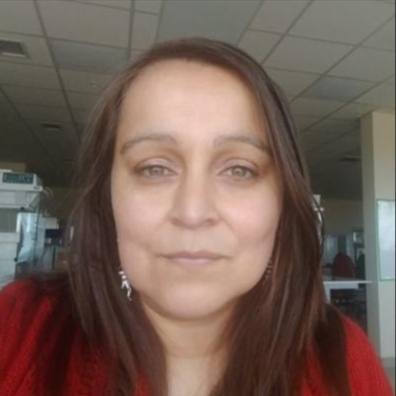
Daniela Rebolledo
Senior Research Assistant

I am a Biochemist from Pontificia Universidad Católica de Chile (PUC) and PhD in Cell and Molecular Biology from the same university. My PhD thesis research was performed at the Physiology and Biophysics department, University of Washington. My research has focused on the physiology of the neuromuscular system and the pathological mechanisms behind neuromuscular disorders of diverse etiology.

Karina Girardi do Carmo
Postdoctoral fellow

Biologist, Ph.D., and MSc in Cell and Molecular Biology from Oswaldo Cruz Foundation (Fiocruz/RJ). Studying age-dependent decline of regenerative capacity in the peripheral nervous system. Mainly focusing on the contribution of metabolic profile of aging Schwann cells in senescence and particularly exploring the epithelial-mesenchymal transition (EMT) like process.
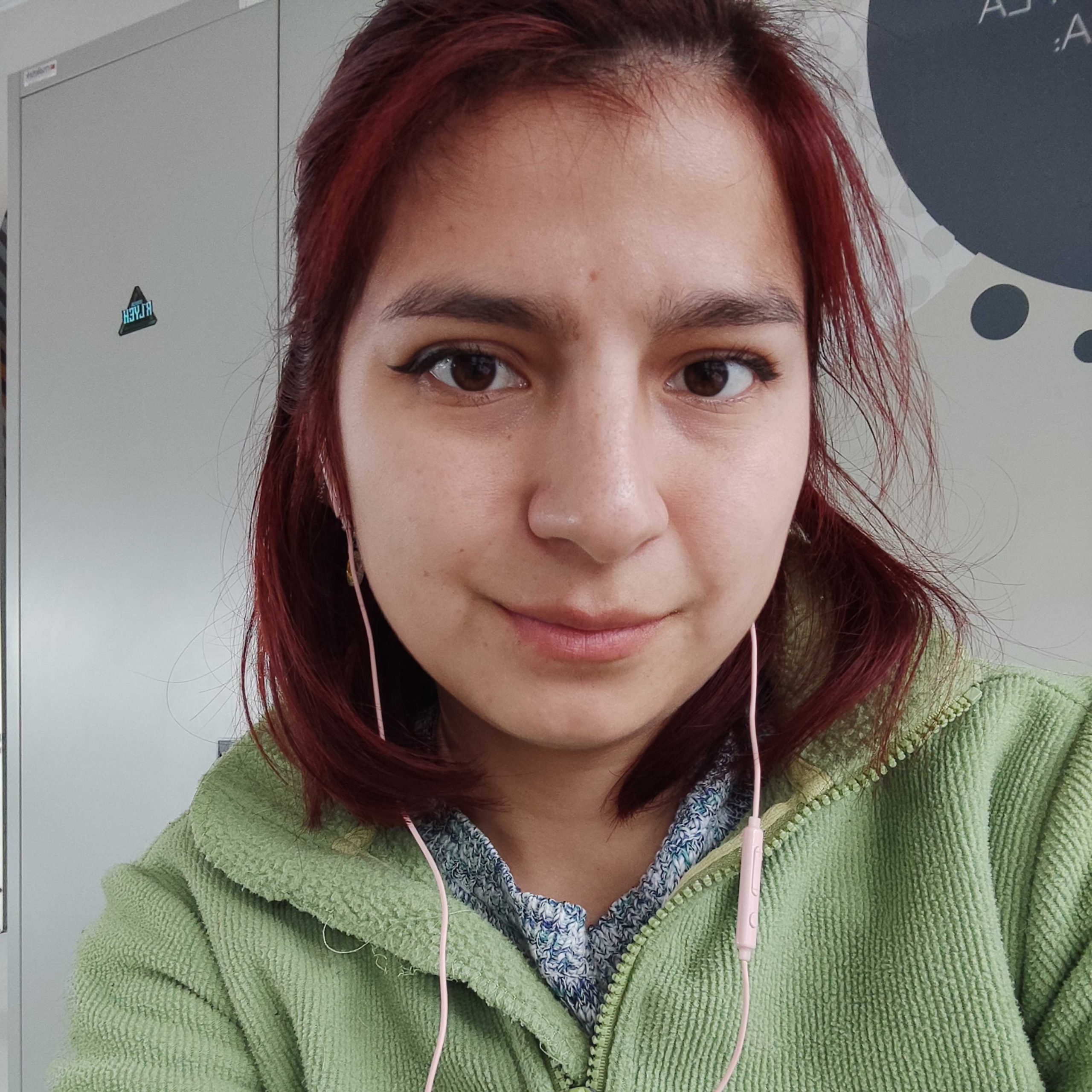
Renata Gallardo
Research Assistant

I studied Medical Technology at the Universidad Mayor acquiring knowledge in histological techniques, immunohistochemistry and immunofluorescence. I am interested in learning more from the world of neurosciences and related pathologies to find new treatments to improve the quality of life in aging.

Camila Duran
Research Assistant

Molecular Biotechnology Engineer from the University of Chile with experience in the study of the cellular and molecular mechanisms of Cdk5 (kinase) involved in peripheral nociception, specifically in its participation in orofacial pain signaling (odontoblasts, trigeminal ganglion and spinal trigeminal nucleus).
Related Publications
PUBLICATIONSReviewNervous System FxNeuroRegeneration
octubre 5, 2021
Applying extracellular vesicles based therapeutics in clinical trials – an ISEV position paper.
Lener T, Gimona M, Aigner L, Börger V, Buzas E, Camussi G, Chaput N, Chatterjee D, Court FA, Del Portillo HA, O'Driscoll L, Fais S, Falcon-Perez JM, Felderhoff-Mueser U, Fraile L, Gho YS, Görgens A, Gupta RC, Hendrix A, Hermann DM, Hill AF, Hochberg F, Horn PA, de Kleijn D, Kordelas L, Kramer BW, Krämer-Albers EM, Laner-Plamberger S, Laitinen S, Leonardi T, Lorenowicz MJ, Lim SK, Lötvall J, Maguire CA, Marcilla A, Nazarenko I, Ochiya T, Patel T, Pedersen S, Pocsfalvi G, Pluchino S, Quesenberry P, Reischl IG, Rivera FJ, Sanzenbacher R, Schallmoser K, Slaper-Cortenbach I, Strunk D, Tonn T, Vader P, van Balkom BW, Wauben M, Andaloussi SE, Théry C, Rohde E, Giebel B.
J Extracell Vesicles. 2015 Dec 31;4:30087. doi: 10.3402/jev.v4.30087. eCollection 2015.
PMID: 26725829
PUBLICATIONSDataNervous System FxPNSCNS
octubre 4, 2021
The p75 neurotrophin receptor evades the endolysosomal route, favouring multivesicular bodies specialised for exosomal release in neuronal cells.
Escudero CA, Lazo OM, Galleguillos C, Parraguez JI, Lopez-Verrilli MA, Cabeza C, Leon L, Saeed U, Retamal C, Gonzalez A, Marzolo MP, Carter BD, Court FA, Bronfman FC.
J Cell Sci. 2014 May 1;127(Pt 9):1966-79. doi: 10.1242/jcs.141754. Epub 2014 Feb 25.
PMID: 24569882
octubre 4, 2021
Control of dopaminergic neuron survival by the unfolded protein response transcription factor XBP1.
Valdés P, Mercado G, Vidal RL, Molina C, Parsons G, Court FA, Martinez A, Galleguillos D, Armentano D, Schneider BL, Hetz C.
Proc Natl Acad Sci U S A. 2014 May 6;111(18):6804-9. doi: 10.1073/pnas.1321845111. Epub 2014 Apr 21.
PMID: 24753614
PUBLICATIONSDataCNSNeuroRegeneration
octubre 4, 2021
Sprouting of axonal collaterals after spinal cord injury is prevented by delayed axonal degeneration.
Collyer E, Catenaccio A, Lemaitre D, Diaz P, Valenzuela V, Bronfman F, Court FA.
Exp Neurol. 2014 Nov;261:451-61. doi: 10.1016/j.expneurol.2014.07.014. Epub 2014 Jul 28.
PMID: 25079366
Related News
Científico advierte que la penalización de la marihuana limita las investigaciones sobre su uso medicinal
diciembre 14, 2022
Giovanni Marsicano, académico de la Universidad de Burdeos, visitó la U. Mayor para exponer sobre el trabajo que durante las últimas décadas lo ha convertido en uno de los investigadores más…
Trabajo colaborativo de académicos U. Mayor usa moscas para entender las consecuencias del bullying
agosto 18, 2022
El Dr. Gonzalo Olivares, del Centro de Biología Integrativa, se encuentra desarrollando el proyecto junto al Dr. Felipe Court, director del CIB y el Dr. Esteban Calvo, director del Centro de…

